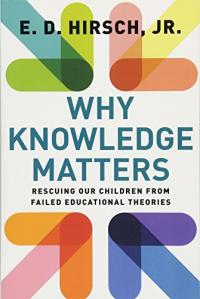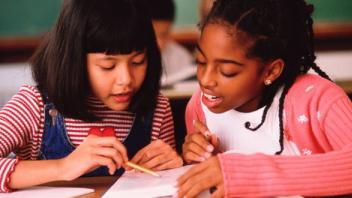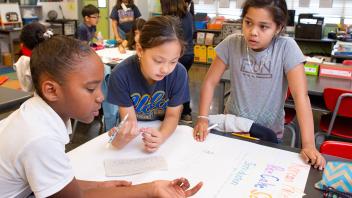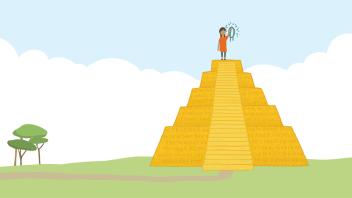The ability to think critically — like the ability to understand what you read — can’t be taught directly and in the abstract. It’s inextricably linked to how much knowledge you have about the situation at hand.”
Natalie Wexler, The Knowledge Gap
Kids naturally have limited knowledge about the world because they have fewer experiences to draw on and make connections to, as they learn. Without more background knowledge — the information one already knows about particular topics — kids start out with a smaller capacity to learn.
Luckily, background knowledge can be easily developed as kids experience the world with their family. Every trip to the store, walk through the neighborhood, and scooter ride to the park, builds kids’ accumulated information about themselves, other people, and the world around them through observations, interactions, and instruction.
Knowledge brings more knowledge
How do we make sense of something we hear or read?
A picture or a familiar word may help us make a connection to understanding, but without a lot of background knowledge that connection is often lost. Children experience the same thing as they are listening and reading. They add to their knowledge base or schema by connecting new information to their prior knowledge. You can think of it as a web of knowledge that children continue to expand as they learn more and more.
Strong background knowledge enables readers to make inferences and to make sense of words that have multiple meanings. Children are continually building key background knowledge while simultaneously using that new knowledge to acquire even more knowledge.
In the article How Knowledge Helps, University of Virginia cognitive psychologist Daniel Willingham explains how knowledge brings more knowledge and improves thinking:
Knowledge is not only cumulative, it grows exponentially. Those with a rich base of factual knowledge find it easier to learn more — the rich get richer. In addition, factual knowledge enhances cognitive processes like problem solving and reasoning. The richer the knowledge base, the more smoothly and effectively these cognitive processes operate.”
Strategies for building background knowledge
What about children who don’t have a lot of background knowledge about what they are learning?
When children don’t have prior knowledge about a subject, they are starting their web of understanding from scratch. Luckily, spending a little bit of time building children’s conceptual and vocabulary knowledge can have huge benefits to their reading and listening comprehension. Two things are key: encouraging children to make connections to their previous experiences and related knowledge, and intentionally introducing and discussing new information and connecting it to what students already know.
Here are a few simple but effective ways to build children’s prior knowledge through interactive and engaging learning:
Dialogic read alouds
The best read alouds are very interactive: You are talking about and reading the story, asking questions about the characters, and possibly wrestling with a rich, new vocabulary word. Conversation is encouraged. Research shows that dialogic reading builds oral language, vocabulary, and comprehension skills.
Conceptually connected text sets
Collection of texts and other materials on a topic or theme give kids multiple ways to learn about a topic. Text sets offer a mix of genres and reading levels, and can also include magazine and newspaper articles, primary source materials like letters and photographs, infographics, timelines, video, and podcasts.
Books + hands-on activities
Pair books with related hands-on activities and real-life experiences (such as trips to the museum or fire station) to help kids connect new information to existing knowledge, figure out how the world works, and understand and gain new knowledge and vocabulary. Our companion website, Start with a Book, has lots of topics and themed toolkits to explore.
Jigsaw strategy
Introduce a thematic topic for the class to learn about, then organize kids into groups, each one with a specific focus on that topic. After a time, bring all the groups together to share what they’ve learned. Jigsaw is a great strategy for kids that like to dive deep into a subject, and gives them a chance to shine. Learn more about Jigsaw.
Concept sorts
Provide kids with a list of terms or concepts from a text, then ask them place words into different categories based on each word’s meaning. Concept sorts provide teachers with information about how much the students already know about a topic, and familiarize students with vocabulary they will encounter in the text. See more about Concept Sorts.
Word maps
Select one or more new vocabulary words from a text you’re reading. Have kids answer the questions “What is it?” “What is it like?” and “What are some examples?” Encourage students to use synonyms, antonyms, create their own “kid definition,” and a picture to help illustrate the new word or concept. Find out more about Word Maps.
Analogies
Analogies help children build knowledge because they compare something new to something kids already know. For example, try something like, “bird is to nest as bee is to… (hive).” Children can also use similes (comparisons using the words like or as) or metaphors (comparisons without using like or as) to build new knowledge.
Timelines and maps
Draw and label a timeline to show the beginning, middle, and end of the story they’ve just read. Or try a whole-class story sequence activity. Or draw a map of the setting in the story. Both activities give kids practice summarizing key elements of a text.
Realia
Use concrete objects — often called “realia” — to tap into what students may already know, and then connect it to building new knowledge. In the video below, watch a second grade teacher use realia to introduce a classroom read-aloud.
Think-alouds
Read a selected passage aloud. At certain points stop and “think aloud” questions and answers, modeling what good readers do. For example, if you’re reading A River Dream by Allen Say, you might say “This book reminds me of the time my father took me fishing. Do you remember a time when you went fishing or did something fun outside with your family?” Or, if you’re reading Stellaluna by Janell Cannon, you might encourage discussion by saying “This story helps me understand that we are all the same in many ways, but it’s our differences that make us special.”
Rich teacher talk
Education professor Nonie Lesaux’s research reveals that “teacher talk” — the number of complex words that teachers use in classrooms — has a substantial impact on how well children read. Lesaux says,
The words that educators use, whether they’re teaching a lesson, having a discussion with students, or even recounting the weekend — it’s the consistent voice in our classrooms. And the daily talk that students are exposed to is essential for developing their minds. It’s a key ingredient for building up their knowledge of the world, their understanding of concepts and ideas.”
Things to keep in mind
- How much instructional time you spend building children’s background knowledge should in part be guided by the depth and breadth of the text children will hear or read. A simple text with few word changes may require a one minute picture walk, pointing out one or two words, and discussing any questions about what children see in the pictures supporting the text. On the other hand, a picture book with more conceptual depth and richer vocabulary deserves a longer discussion (5-7 minutes) to build background knowledge.
- Consider how you can group concepts and vocabulary together to discuss how they compare and contrast, and ultimately are connected. As Charlotte tells Wilbur in Charlotte’s Web:
A spider’s web is stronger than it looks. Although it is made of thin, delicate strands, the web is not easily broken.”
We want our children to weave strong webs of knowledge that anchor and expand their understanding as they develop into lifelong readers, writers, and thinkers.
Knowledge Matters
The Knowledge Matters Campaign raises awareness of the importance of content knowledge in reading comprehension and critical thinking, and showcases schools that are using knowledge-rich curricula.
Featured video
Why prior knowledge wins the game
Natalie Wexler shares a study that gives evidence that prior knowledge is more important than general skill in reading comprehension, and she makes the case that this is one of the roots of the achievement gap.
A matter of talk
Harvard education professor Nonie Lesaux shares her research which indicates that complex, rich teacher talk in the classroom can have a striking positive effect on students’ language and reading growth.
Active read alouds: bringing nonfiction to life
Position Statement on the Role of Nonfiction Literature (K–12)
“Contemporary nonfiction for young people plays a crucial role in the reading and writing lives of K–12 students. It is a rich and compelling genre that supports students’ development as critically, visually, and informationally literate 21st century thinkers and creators.” Read more in this position statement from the National Council of Teachers of English. Position Statement on the Role of Nonfiction Literature (K–12)
Using jigsaw in the classroom
Go inside Cathy Doyle’s second grade classroom in Evanston, Illinois to observe her students use the jigsaw strategy to understand the topic of gardening more deeply and share what they have learned. Joanne Meier, our research director, introduces the strategy and talks about the importance of advanced planning and organization to make this strategy really effective.
More video
Learn more about background knowledge
Background Knowledge
Growing Knowledge Matters. A Lot.
Background Knowledge
Building Background Knowledge
Background Knowledge
Accessing Students’ Background Knowledge in the ELL Classroom
Background Knowledge
Connect Students’ Background Knowledge to Content in the ELL Classroom
Background Knowledge
How Knowledge Helps
Content Area Literacy
Building World Knowledge: Motivating Children to Read and Enjoy Informational Text
Background Knowledge
Knowledge in the Classroom
Background Knowledge
Pairing Books, Activities, and Experiences to Build Background Knowledge
Background Knowledge
How to Read Nonfiction Text
Books and guides on background knowledge

The Knowledge Gap

Why Knowledge Matters
Research and journal articles
Journal articles
- The Case for Bringing Content into the Language Arts Block and for a Knowledge-Rich Curriculum Core for all Children by E.D. Hirsch, Jr. (AFT’s American Educator)
- Rethinking How to Promote Reading Comprehension by Hugh Catts (AFT’s American Educator)
- What a Knowledge-Building Approach Looks Like in the Classroom by Barbara Davidson and David Liben (IDA’s Perspectives on Language and Literacy)
- The Connections Between Writing, Knowledge Acquisition, and Reading Comprehension by Judith C. Hochman and Natalie Wexler (IDA’s Perspectives on Language and Literacy)
Browse our background knowledge resource library
Learn more about how to build background knowledge, what a knowledge-rich curriculum looks like, the role of nonfiction texts, tips for parents, video, and research briefs. Visit our Background Knowledge section









